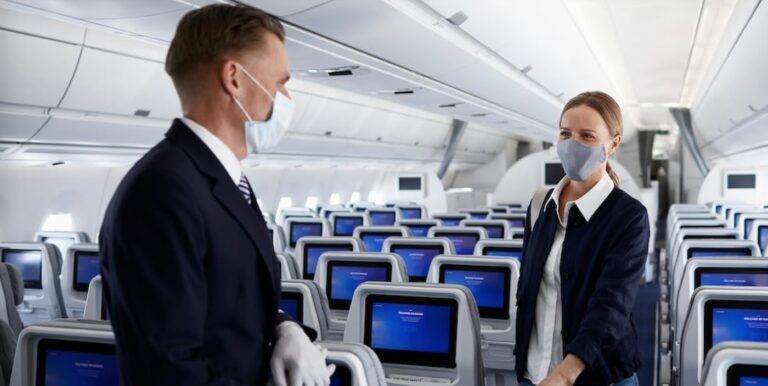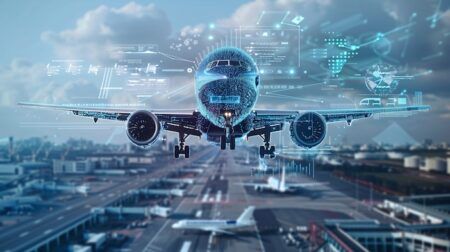According to medical evidence, a passenger’s risk of inflight transmission of SARS-CoV-2 is likely to be low or extremely low. The reasons for the apparently low rate of inflight transmission are not known yet, but could encompass a combination of the lack of face-to-face contact, and the physical barriers provided by seatbacks, along with the characteristics of cabin air flow.
In commercial aircraft the cabin air is replaced on average every three minutes. Air circulation patterns on board standard commercial aircraft are side-to-side, with air entering the cabin from overhead, circulating across the aircraft and exiting near the floor. There is little longitudinal (front-to-back) airflow. The cabin air is a mix of recirculated and fresh outside air. The outside air is assumed to be sterile at typical cruising altitudes. All air passes through high-efficiency particulate air (HEPA) filters that filter >99.97% of particles in the air, including bacteria and viruses. The resulting air quality has been shown to meet the same standards as hospital operating theatres.
Have cases of transmission of SARS-COV-2 during a flight been identified?
Looking at what has been published on this topic in medical publications, there is only one paper that suggests a probable aircraft transmission of SARS-CoV-2 in-flight (1).
One paper from Canada reports the careful follow up of a long-haul flight on which a passenger was later confirmed to have been unwell at the time, but no secondary cases resulted (1). In another report, a flight from the USA to China with 11 people on board who were subsequently confirmed to be symptomatic at the time, similarly had, at the time of writing, generated no secondary confirmed cases from around 300 passengers tested (2).
An inquiry to 70 airlines (representing half of global passenger traffic) failed to identify any cases of suspected passenger-to-passenger transmission (3). Naturally research continues on this topic, but looking at the evidence so far, the risk of transmission in an aircraft seems to be very low.
Do face masks help prevent transmission of viruses?
Droplet transmission seems to be the major mode of contracting SARS-CoV-2, with a possibility of transmission through contact with [infected] surfaces. Generally, droplets are propelled short distances (<1m) when an infected person sneezes, coughs or talks. A person with any respiratory symptoms will be denied boarding on Finnair flights.
In line with EASA’s recommendations, Finnair requires that passengers wear masks during the flight to tackle the risk of asymptomatic carriers transmitting the virus. By wearing a mask, we all protect each other.
Should we be concerned about transmission via contact with surfaces?
Cleaning with normal agents such as alcohol >70% is very effective at destroying the virus on such surfaces. Many airlines have increased the frequency and extent of their routine cleaning, and also the European Aviation Safety Authority (EASA) has updated the instructions on cleaning. At Finnair, for instance, the frequency of cleaning has been intensified, with special focus on high-touch surfaces.
We also provide customers with sanitising wipes, so that you can clean your table for example before eating. It is also a good practice to carry with your own hand sanitiser and disinfecting wipes when you travel, as it is not always possible to wash hands regularly during a trip.

What of the many people who say they feel ill after flying?
Cabin air is dry, and that can irritate mucous membranes in some people. But the incubation period of a respiratory virus varies from a few days to a week, so if you get a flu right after a flight, you most likely have caught it well before the flight.
Travellers have a higher risk of catching a viral infection in public transportation or at the airport when touching surfaces that many people touch. That is why it is important to wash your hands and avoid touching your own face.
How can passengers ensure their health safety on board?
First of all, passengers with any signs of a respiratory tract infection can be denied boarding the flight, so do not travel if you feel unwell.
Secondly, physically distancing the passengers at the airport (e.g. at check-in, security checks, boarding gate, baggage retrieval) and during boarding and deplaning is likely to achieve significant risk reduction.
Maintaining physical distance is not always possible in the aircraft. The solution then – as recommended also by EASA – is requiring passengers to wear masks during the flight to tackle the risk of asymptomatic carriers transmitting the virus. Masks have been obligatory on Finnair flights since May 18th 2020.
By adhering to the recommended means of reducing the risk of SARS-CoV-2 transmission – physical distancing, good hand hygiene and not travelling when you are ill – you can be confident in the safety of air travel, even during the pandemic.

References:
1) Eldin C, Lagier J-C, Mailhe M, Gautret P. Probable transmission of COVID-19 in-flight from the Central African Republic to France. Travel Medicine and Infectious Disease; (accessed Apr 26, 2020)
2) Schwartz KL, Murti M, Finkelstein M, et al. Lack of COVID-19 transmission on an international flight. CMAJ 2020 Apr 14; 192: E410.doi: 10.1503/cmaj.75015





